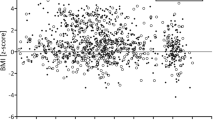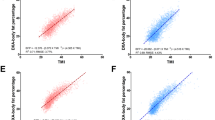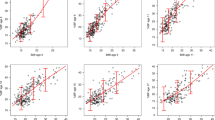Abstract
Objective:
Nutritional status is assessed by measuring BMI or percent body fat (%fat). BMI can misclassify persons who carry more weight as fat-free mass and %fat can be misleading in cases of malnutrition or in disease states characterized by wasting of lean tissue. The fat-free mass index (FFMI) is proposed to assess body composition in individuals who have a similar body composition but differ in height allowing identification of those suffering from malnutrition, wasting or those that possess a relatively high muscle mass. The purpose was to determine whether the FFMI differs in a group of racially/ethnically diverse adults.
Design:
Cross-sectional.
Subjects:
Subjects were a multi-ethnic sample (Caucasian, CA; African American, AA; Hispanic, HIS and Asian, AS) of 1339 healthy males (n=480) and females (n=859) ranging in age from 18—110 years. Total body fat, total fat-free mass and bone mineral density were estimated using dual energy X-ray absorptiometry.
Results:
FFMI differed among the four ethnic groups (P⩽0.05) for both genders. A curvilinear relationship was found between age and FFMI for both genders although the coefficients in the quadratic model differed between genders (P⩽0.001) indicating the rate of change in FFMI differed between genders. The estimated turning point where FFMI started to decline was in the mid 20s for male and mid 40s for female participants. An age × gender interaction was found such that the rate of decline was greater in male than female participants (P⩽0.001). For both genders, FFMI was greatest in AA and the least in AS (P⩽0.001). There was no significant interaction between race and age or age2 (P=0.06). However, male participants consistently had a greater FFMI than female participants (P⩽0.001).
Conclusions:
These findings have clinical implications for identifying individuals who may not be recognized as being malnourished based on their BMI or %fat but whose fat-free mass corrected for height is relatively low.
This is a preview of subscription content, access via your institution
Access options
Subscribe to this journal
Receive 12 print issues and online access
$259.00 per year
only $21.58 per issue
Buy this article
- Purchase on Springer Link
- Instant access to full article PDF
Prices may be subject to local taxes which are calculated during checkout


Similar content being viewed by others
References
Allison DB, Faith MS, Heo M, Kotler DP . Hypothesis concerning the U-shaped relation between body mass index and mortality. Am J Epidemiol 1997; 146: 339–349.
VanItallie TB, Yang MU, Boileau RA, Heymsfield S . Applications of body composition technology in clinical medicine: some issues and problems. In: Kral JG, VanItallie TB (eds). Recent Developments in Body Composition Analysis: Methods and Applications. Smith-Gordon: Great Britain, 1993, pp 87–97.
Heymsfield SB, Lohman TG, Wang Z, Going SB . Human Body Composition. Human Kinetics: Champaign, IL, 2005.
VanItallie TB, Yang MU, Heymsfield SB, Funk RC, Boileau RA . Height-normalized indices of the body′s fat-free mass and fat mass: potentially useful indicators of nutritional status. Am J Clin Nutr 1990; 52: 953–959.
Gallagher D, Heymsfield SB, Heo M, Jebb SA, Murgatroyd PR, Sakamoto Y . Healthy percentage body fat ranges: an approach for developing guidelines based on body mass index. Am J Clin Nutr 2000; 72: 694–701.
Heitmann BL . Body fat in the adult Danish population aged 35–65 years: an epidemiological study. Int J obesity 1991; 15: 535–545.
Kyle UG, Genton L, Slosman DO, Pichard C . Fat-free and fat mass percentiles in 5225 healthy subjects aged 15–98 years. Nutrition (Burbank, Los Angeles County, Calif) 2001; 17: 534–541.
Barlett HL, Puhl SM, Hodgson JL, Buskirk ER . Fat-free mass in relation to stature: ratios of fat-free mass to height in children, adults, and elderly subjects. Am J Clin Nutr 1991; 53: 1112–1116.
Schutz Y, Kyle UU, Pichard C . Fat-free mass index and fat mass index percentiles in Caucasians aged 18–98 y. Int J Obes Relat Metab Disord 2002; 26: 953–960.
Gallagher D, Ruts E, Visser M, Heshka S, Baumgartner RN, Wang J et al. Weight stability masks sarcopenia in elderly men and women. Am J physiol 2000; 279: E366–E375.
Park YW, Allison DB, Heymsfield SB, Gallagher D . Larger amounts of visceral adipose tissue in Asian Americans. Obesity Res 2001; 9: 381–387.
Vozarova B, Wang J, Weyer C, Tataranni PA . Comparison of two software versions for assessment of body-composition analysis by DXA. Obesity Res 2001; 9: 229–232.
He Q, Heo M, Heshka S, Wang J, Pierson Jr RN, Albu J et al. Total body potassium differs by sex and race across the adult age span. Am J Clin Nutr 2003; 78: 72–77.
Wang Z, Zhu S, Wang J, Pierson Jr RN, Heymsfield SB . Whole-body skeletal muscle mass: development and validation of total-body potassium prediction models. Am J Clin Nutr 2003; 77: 76–82.
Berne RM, Levy MN . Physiology, 4th edn. Mosby: St. Louis, 1998.
Harman SM, Metter EJ, Tobin JD, Pearson J, Blackman MR . Longitudinal effects of aging on serum total and free testosterone levels in healthy men. Baltimore Longitudinal Study of Aging. J Clin Endocrinol Metabol 2001; 86: 724–731.
Pichard C, Kyle UG, Morabia A, Perrier A, Vermeulen B, Unger P . Nutritional assessment: lean body mass depletion at hospital admission is associated with an increased length of stay. Am J Clin Nutr 2004; 79: 613–618.
Kyle UG, Pirlich M, Lochs H, Schuetz T, Pichard C . Increased length of hospital stay in underweight and overweight patients at hospital admission: a controlled population study. Clin Nutr (Edinburgh, Scotland) 2005; 24: 133–142.
Broadwin J, Goodman-Gruen D, Slymen D . Ability of fat and fat-free mass percentages to predict functional disability in older men and women. J Am Geriatr Soc 2001; 49: 1641–1645.
Acknowledgements
This study was supported by NIH T32-DK007559-19, DK42618, P30-DK-26687, RR24156.
Author information
Authors and Affiliations
Corresponding author
Ethics declarations
Competing interests
The authors declare no conflict of interest.
Additional information
Author Contributions
Hull, Wang and Gallagher were responsible for the conception of this paper. Wang, Pierson, Pi-Sunyer, Heymsfield, Albu, Fernandez and Gallagher participated in data collection. Thornton and Hull were responsible for the analysis and interpretation of data. Hull, Van Itallie, Wang, Thornton, Pierson, Kaleem, Pi-Sunyer, Heymsfield, Albu, Fernandez and Gallagher were responsible for the critical review of the article for intellectual content. Thornton was in charge of the statistical expertise. Gallagher supervised the study.
Rights and permissions
About this article
Cite this article
Hull, H., Thornton, J., Wang, J. et al. Fat-free mass index: changes and race/ethnic differences in adulthood. Int J Obes 35, 121–127 (2011). https://doi.org/10.1038/ijo.2010.111
Received:
Revised:
Accepted:
Published:
Issue Date:
DOI: https://doi.org/10.1038/ijo.2010.111
Keywords
This article is cited by
-
Reference values for body composition and associations with blood pressure in Kenyan adults aged ≥50 years old
European Journal of Clinical Nutrition (2019)
-
Relationships between the lean mass index and bone mass and reference values of muscular status in healthy Chinese children and adolescents
Journal of Bone and Mineral Metabolism (2016)
-
Reference Values of Total Lean Mass, Appendicular Lean Mass, and Fat Mass Measured with Dual-Energy X-ray Absorptiometry in a Healthy Mexican Population
Calcified Tissue International (2016)
-
Liver fat accumulation in response to overfeeding with a high-fat diet: a comparison between South Asian and Caucasian men
Nutrition & Metabolism (2015)
-
Sex and race/ethnic disparities in the cross-sectional association between depressive symptoms and muscle mass: the Multi-ethnic Study of Atherosclerosis
BMC Psychiatry (2015)



